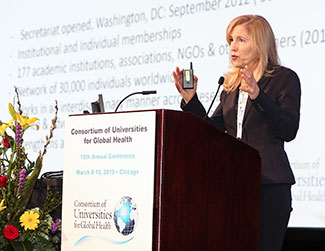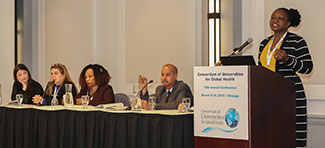Consortium of Universities for Global Health (CUGH) annual meeting examines implementing solutions for impact
March / April 2019 | Volume 18, Number 2

Consortium of Universities for Global Health Chair Dr. Ann
Kurth opened the 2019 annual meeting with a call for action
to advance implementation science.
Kurth opened the 2019 annual meeting with a call for action
to advance implementation science.

Photos courtesy of CUGH
More than 1,750 academics, practitioners, administrators,
students and others, representing 50 countries, attended the
CUGH 2019 annual meeting in Chicago, Illinois.
students and others, representing 50 countries, attended the
CUGH 2019 annual meeting in Chicago, Illinois.
By Ann Puderbaugh
CHICAGO - With a mandate to improve health across the planet, attendees of the 10th annual meeting of the Consortium of Universities for Global Health (CUGH) were encouraged to unleash the unique power of their institutions to enhance the translation and implementation of knowledge so the world’s underserved can benefit. “We know that putting what works into scale will save millions of lives,” said CUGH chair, Dr. Ann Kurth, in her opening address. “We need to work together across borders and across ideologies,” she said, encouraging attendees to synergize efforts to improve health for all.
More than 1,750 academics, practitioners, administrators, students and others, representing 50 countries, attended the gathering. In keeping with the conference’s implementation science theme, Fogarty’s Center for Global Health Studies (CGHS) organized a panel discussion to explore ways to advance the field.
“We need a more coordinated approach to implementation science capacity building that identifies the most useful content for stakeholders,” said Dr. Rohit Ramaswamy of the University of North Carolina. He’s been developing a multi-tiered concept to provide different, but complementary, levels of training for researchers, implementers, policymakers and those involved in care delivery. It’s not helpful if trainees return home ready to put implementation science theories into practice but their stakeholders don’t understand what they’re talking about, Ramaswamy noted.
Two case studies of HIV-related implementation science projects that were shepherded by Fogarty’s CGHS were presented. With adolescents identified as a key population for disease transmission in Africa, a collaboration has been established to enhance effective use of evidence to improve HIV prevention, screening and treatment of young Africans, aged 15-24. The Adolescent HIV Prevention and Treatment Implementation Science Alliance (AHISA) provides a space to facilitate dialogue and exchange of ideas among researchers, implementers and decision makers, said Fogarty’s Dr. Rachel Sturke, who manages the program.
An initiative to prevent mother-to-child-transmission of HIV - another CGHS project - resulted in formation of theNigeria Implementation Science Alliance (NISA) , a national effort to coordinate research and capacity building efforts among stakeholders. Established in 2015 with a focus on research productivity and development of independent investigators, NISA has already generated two funded NIH grant proposals and more than seven published research papers. Projects are always multi-site, multi-partner and involve issues that have potential for national scope and impact, said Dr. Nadia Sam-Agudu, of Nigeria’s Institute of Human Virology and a faculty member at the University of Maryland.
To strengthen NIH’s global mental health initiatives concerning children, the National Institute of Mental Health (NIMH) co-hosted a workshop during the conference to gain insights that will inform its future programs. Eighty-five percent of the world’s youth live in low- and middle-income countries (LMICs), where access to diagnosis and treatment is lacking. “Youth mental illness is one of the most urgent mental health problems worldwide,” according to NIMH Director Dr. Joshua Gordon. “Early interventions can improve outcomes,” he said, yet there has been little research on how to apply existing knowledge and practices for use in low-resource settings. Proven diagnostic techniques - such as using mobile devices to track eye contact in young children - could be adapted for use in LMICS so that diagnosis and treatment of autism could begin earlier, he said. Using cellphones or other portable devices to administer such tests “is imminently implementable worldwide.” Read more in Dr. Gordon's related February 2019 blog post on global mental health.
But implementation without maintaining quality of care is also an enormous problem in LMICs. In a session organized by Fogarty, panelists presented the results of a recent U.S. National Academies of Sciences, Engineering and Medicine (NASEM) report, Crossing the Global Quality Chasm: Improving Health Care Worldwide , that shows up to 8 million deaths occur each year from lack of access and poor quality of care in developing countries - more than HIV, TB and malaria combined. The study examined what an ideal health system would look like and recommended a shift in focus and ownership of health to the communities, said Dr. Marcel Yotebieng, an author of the report and faculty member of Kinshasa University and Ohio State. NIH funds a broad range of studies on how to improve quality of care through 18 grants in 14 LMICs, said Fogarty’s Dr. Linda Kupfer, who helped coordinate NIH’s participation in the NASEM report. NIH-funded projects focus on issues such as mobile health, HIV/AIDS, hypertension, diabetes and other noncommunicable diseases.

Photos courtesy of CUGH
Fogarty’s Dr. Ken Bridbord was awarded CUGH’s
highest honor by its director, Dr. Keith Martin.
Read more about the recipients of the CUGH
2019 Distinguished Leadership Award.
highest honor by its director, Dr. Keith Martin.
Read more about the recipients of the CUGH
2019 Distinguished Leadership Award.
Financial corruption in the health sector is widespread in LMICs and also reduces access and quality of care by starving systems of much-needed resources, said longtime Fogarty grantee Dr. Patty Garcia, in a plenary address. A professor at the Universidad Peruana Cayetano Heredia in Peru, Garcia said she has lived her life surrounded by corruption. “It has a disproportionate impact on the poor,” she said. “Corruption is abuse and it violates the rights of individuals and communities.” After experiencing health spending fraud firsthand during her tenure as her country’s health minister, she looked into research on the topic and found it lacking. But she discovered there are two theories on how to reduce corruption. One calls for strong institutions and a national integrity system, and the other proposes a holistic approach that considers social norms and how citizens view participating in fraudulent practices. It will take more than political will to address corruption, she said. “We need to do research on how to intervene against corruption in our health systems.”
At another session, Fogarty Fellows and Scholars shared stories of their early-career experiences at NIH research sites and the positive outcomes that resulted. The program’s first landscape architect, Dr. Leann Andrews of the University of Washington, presented her successful efforts to improve a Peruvian slum community’s health by working with residents to construct shared and household gardens full of herbs, medicinal plants, fruits and vegetables. By making their surroundings safer and more attractive, boosting food security and access to medicines, and improving water quality, she found residents reported a decrease in depression and gastrointestinal illness, as well as fewer falls and injuries.
Another Fogarty Fellow, Dr. Lameck Chinula, studied thermocoagulation treatment of cervical cancer in Malawi. The support and professional relationships formed during his fellowship “fast-tracked my early-career stage development,” he said, and helped him secure funding to continue his research.
Establishing the prevalence and risk factors of mental illness in a Kenyan community was the focus of Dr. Edith Kwobah’s Fogarty fellowship. In her survey of 420 residents, she discovered nearly half had a mental disorder, with 15 percent identified as having anxiety and nearly 7 percent considered suicidal. Increasing access to care is her main concern, she said. She has trained primary health care workers and volunteers to screen community members for depression and other mental health issues while they are providing general health services.
Dr. Elena Cyrus spent two years in Lima, Peru as a Fogarty Fellow studying HIV infection among transgender women and men who have sex with men, two populations that bear a disproportionate burden of the disease. She said her research goal is to inform prevention efforts that are specially tailored for these groups.


Photos courtesy of CUGH
CUGH sessions on implementation science (top) and
strengthening mentoring in LMICs (bottom) featured
current and former grantees, and representatives from
Fogarty.
strengthening mentoring in LMICs (bottom) featured
current and former grantees, and representatives from
Fogarty.
One of the program’s early participants, Dr. Paul Drain, completed a Fogarty fellowship in Tanzania in 2005, which sparked his interest in point-of-care diagnostics. Now an assistant professor at the University of Washington, he said the experience was “transformative and incredibly helpful for my career.”
Fogarty Director Dr. Roger I. Glass said he was encouraged by the caliber of these emerging global health leaders. “I’m so proud of you all and to see that by investing in young researchers, through the impact of this program, we are launching careers that will endure for 20 to 30 years and result in real benefits in research discoveries.”
In another session, Glass offered inspiration to students who are trying to map out global health careers. “The lessons you learn, the friendships and partnerships you form early on that endure for life are so valuable. For me, global health has been one of the most enriching experiences of my career.”
Mentoring - essential for early-career scientists - is not often part of the culture at LMIC research institutions. That was the topic of a panel discussion that served to launch asupplement published by the journal of the American Society of Tropical Medicine and Hygiene (ASTMH) that provides recommendations, case studies and an overview of toolkits to spur mentorship programs in low-resource settings.
“This is a call to action, not just an academic discussion,” said ASTMH CEO Karen Goraleski, who introduced the session. “We have to change the way business is being done.”
LMIC scientists need a mentoring approach tailored to their unique circumstances, which often include very divided gender roles, respect for hierarchy and seniority, and a colonial history that has left a legacy of authoritarian attitudes, said Dr. Willy Lescano, a co-author and professor at Peru’s Universidad Peruana Cayetano Heredia.
The publication was inspired by a series of “Mentoring the Mentor” workshops hosted in LMICs by faculty of Fogarty’s Global Health Program for Fellows and Scholars.
“We spend a tremendous amount of our time, resources and thought in training the next generation of global health leaders,” said Glass, “so we really do have an investment in doing this better, in developing a mentoring roadmap for the future, to ensure the satisfaction and success of our trainees, and to keep them on the research track.”
More Information
- Consortium of Universities for Global Health (CUGH) 2019 annual meeting
- Fogarty- and NIH-related sessions at 2019 Consortium of Universities for Global Health (CUGH) annual meeting
- Fogarty’s Center for Global Health Studies (CGHS)
- Fogarty CGHS project: Adolescent HIV Prevention and Treatment Implementation Science Alliance (AHISA)
- Fogarty CGHS project: NIH-PEPFAR PMTCT Implementation Science Alliance
- NIH partner: Nigeria Implementation Science Alliance (NISA)
- Crossing the Global Quality Chasm: Improving Health Care Worldwide
U.S. National Academies of Sciences, Engineering and Medicine (NASEM), August 28, 2018 - Around the world and back again: Global mental health efforts
Blog post by NIMH Director Dr. Joshua A. Gordon, February 27, 2019 - Traction , featuring the work of Fogarty Scholar and landscape architect Dr. Leann Andrews
- Fogarty Scholar Dr Paul Drain helps accelerate disease diagnoses in South Africa
Mar / Apr 2014 Global Health Matters - Mentorship training in LMICs needs increased support
Jan / Feb 2019 Global Health Matters - Dr Ken Bridbord and Dr King Holmes are co-recipients of the Consortium of Universities for Global Health (CUGH) 2019 Distinguished Leadership Award
Mar / Apr 2019 Global Health Matters
To view Adobe PDF files, download current, free accessible plug-ins from Adobe's website .





















.png)









No hay comentarios:
Publicar un comentario